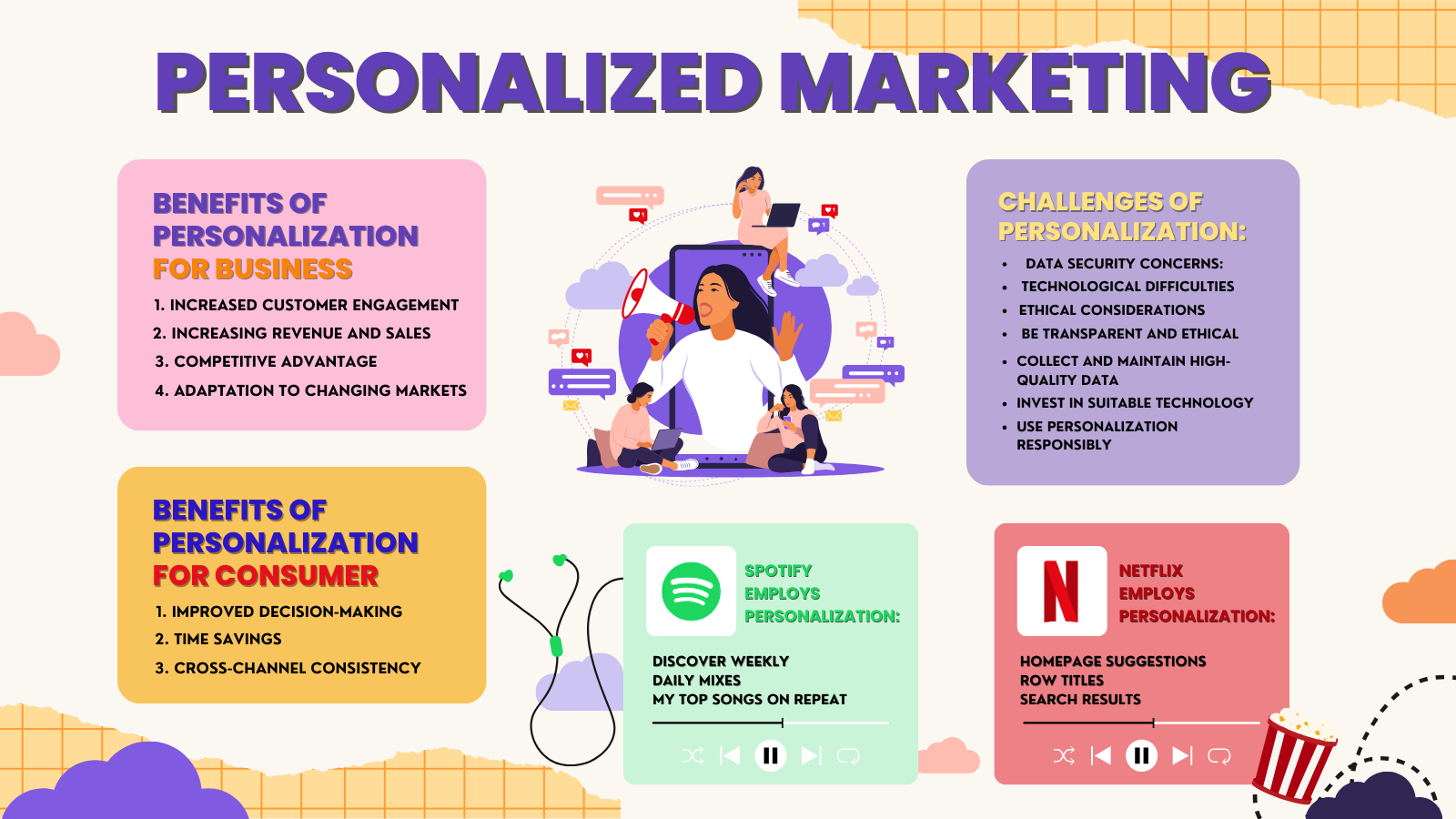
Key Takeaways:
- A key component of contemporary marketing is personalization. It is becoming a need for businesses rather than a luxury.
- Beyond simple segmentation, personalization leverages data and technology to produce customized encounters on a large scale.
- Businesses may gain a lot from personalization, such as better customer experience, greater conversion rates, enhanced customer loyalty, and more customer engagement.
- To win tomorrow’s customization game, firms must have the required skills and capacities to adapt to these transformations.
- Businesses should exercise caution when it comes to customization, since this might leave customers feeling freaked out or watched.
Introduction:
Imagine living in a world where the only advertisements you get are connected to your needs and interests. There would be barely any reason for you to waste time sorting through pointless advertisements or promotions. Instead, you would get customized messages that are more likely to resonate with you.
This is personalization for you.
In marketing, personalization is a strategy used to better engage consumers by getting to know their wants, needs, and motivations. Personalization, on the other hand, goes far beyond simply addressing individuals by their first name in an email. It involves utilizing data and analytics to comprehend the distinct requirements, tastes, and behaviors of every individual and applying those understandings to develop customized experiences that boost engagement, loyalty, and, eventually, conversions. This strategy is frequently called “hyper-targeting.” It is quickly becoming a key component of effective digital marketing plans. Target audiences are divided into groups according to a range of criteria, including location, interests, gender, age, and other factors. Through market segmentation based on comparable attributes, companies can craft customized messaging that increases the likelihood of a sale.
People respond well to personalization because it helps them feel heard and seen. It demonstrates that you value them as individuals and are willing to go the extra mile to improve their experience. Companies are increasingly adopting personalization tactics to better target their consumers, resulting in higher ROI for their efforts.
Benefits of Personalization:
The significance of personalization in marketing has been recognized all over the last several decades. With the emergence of consumer segmentation and data privacy techniques, organizations have found more success when they customize their strategies to target certain groups. It helps in making the customer experience better.
Personalization is beneficial in the business environment in the following ways:
1. Increased Customer Engagement:
- Personalization promotes better customer engagement.
- Consumers are more inclined to deal with companies that are aware of their distinctive demands.
- Higher engagement levels have the potential to boost revenue and build client loyalty.
2. Increasing Revenue and Sales
- The ability of personalized marketing to increase sales and revenue is a fundamental outcome.
- McKinsey conducted a study that discovered personalized marketing messages have a unique rapport with customers, significantly increasing the probability of conversion.
- Indeed, according to this study, personalized marketing efforts can result in a 15% increase in sales.
- The essence of this discovery is that personalized marketing messages cut through the marketing noise and offer products or services that genuinely match their preferences.
3. Competitive Advantage:
- Businesses that embrace personalization gain a distinct competitive advantage in a highly competitive market.
- Personalization represents a company’s constant dedication to meeting the unique needs of its customers. With many of them depending on generic, one-size-fits-all solutions, the competitors are set apart from the company by this dedication.
- This dedication to personalization creates an emotional bond between the company and its customers.
- Customers are more likely to engage with, trust, and remain loyal to a brand that goes above and beyond to provide them with tailored and meaningful experiences as a result.
4. Adaptation to Changing Markets:
- Businesses that implement personalization are better able to adapt quickly to changing consumer preferences and market conditions.
- Companies can stay flexible and stay up to date with the constantly shifting dynamics of the market by continuously analyzing customer data and making necessary adjustments to their strategies.
- In an environment that is marked by quick changes and shifts driven by customers, this dynamic approach is essential to maintaining long-term success and relevance.
Consumers benefit from personalization in a variety of ways, including improved overall experience and satisfaction when interacting with businesses and brands. Personalization benefits consumers in the following ways:
1. Improved Decision-Making:
- Consumers can make more informed decisions with personalized recommendations and information.
- Whether its product recommendations based on previous purchases or content recommendations tailored to their preferences, personalization empowers consumers to make decisions that are more in line with their expectations.
- This tailored approach improves the decision-making process by increasing the likelihood that consumers will choose products and engage with content that resonates with their personal preferences, resulting in a more satisfying and fulfilling experience.
2. Time Savings:
- Personalization minimizes the overwhelming flow of information that consumers face.
- It eliminates the need for consumers to sift through a sea of irrelevant content.
- Instead, it delivers carefully curated content and offers that are relevant to their specific interests, effectively acting as a time-saving mechanism.
- It optimizes their online journey by presenting them with relevant choices and recommendations, ultimately saving valuable time and improving the overall quality of their interactions with businesses and brands.
3. Cross-Channel Consistency:
- Personalization frequently involves multiple communication channels and points of interaction.
- Whether consumers interact with a brand through its website, email correspondence, or mobile application, the personalized experience maintains consistency, resulting in a smooth and user-friendly journey.
- This consistency ensures that consumers have a consistent and convenient experience regardless of the platform they use.
Real time examples of Personalization in action:
The most compelling examples of hyper targeting can be found in everyday digital experiences like Spotify’s personalized playlists and Netflix’s content recommendations.
Let us take a closer look at Spotify.
Spotify analyzes user data, including songs skipped and music listened to, using advanced algorithms. Spotify encourages users to spend more time on the app and engage more deeply with its offerings by delivering personalized content. This level of personalization also fosters a sense of connection and loyalty, leading users to prefer Spotify over other music streaming platforms. Spotify employs personalization in the following ways:
Discover Weekly: Discover Weekly is a weekly personalized playlist that Spotify creates for each user. The playlist is based on the user’s listening habits and includes songs Spotify believes the user will enjoy.
Daily Mixes: A set of personalized playlists that Spotify creates for each user on a daily basis. These playlists are based on the user’s listening habits and include both songs from the user’s library and new songs that Spotify believes the user will enjoy.
My Top Songs: My Top Songs is a customized playlist created by Spotify for each user. This playlist contains the user’s most-listened-to songs from the previous six months.
On Repeat: Spotify creates a personalized playlist for each user called “On Repeat” which features their most recently played songs.
In addition to personalized playlists, Spotify uses personalization to recommend songs and albums on its home page and throughout the platform. When a user searches for a song or an artist, Spotify will recommend other songs and albums that it believes they will enjoy. One of the reasons Spotify is such a popular music streaming service is its personalization features. Spotify helps users discover new music and stay engaged with the platform by recommending music that they are likely to enjoy.
Speaking for Netflix,
Personalization is used by Netflix to recommend movies and TV shows to its users based on their viewing history, preferences, and other factors. This assists users in discovering new content that they are likely to enjoy, as well as keeping them engaged with the platform.
Here are some examples of how Netflix employs personalization:
Homepage suggestions: The movies and TV shows displayed on the Netflix homepage are personalized for each user based on their viewing history and preferences. For example, if a user has recently watched a large number of documentaries, Netflix will recommend additional documentaries to them on their homepage.
Row titles: On the Netflix homepage, the row titles are also personalized. A user may see rows with titles such as “Documentaries You’ll Love” or “TV Shows You Might Like.”
Search results: Search results are personalized based on a user’s watch history and preferences when they search for a movie or TV show on Netflix. For example, if a user has recently watched a lot of comedies, Netflix will prioritize comedies in search results.
Netflix personalizes its recommendations based on a variety of factors, including watch history, ratings and reviews, genres, and mood, my list. One of the reasons Netflix is so popular because of its personalization features. Netflix assists users in discovering new content and staying engaged with the platform by recommending content that they are likely to enjoy. Personalization features on Netflix are constantly evolving. The company is constantly looking for new ways to personalize its recommendations and provide the best possible experience to its users.
Challenges of Personalization:
While personalization can produce impressive results, it is critical to strike a balance between personalization and privacy. Customers are becoming more aware of their digital footprint, and you must ensure that your personalization efforts do not appear intrusive or exploitative. However, there are a number of difficulties associated with personalization.
Here are some of the difficulties associated with personalization:
Data security concerns: Customers are increasingly concerned about the privacy of their personal information. Businesses must be transparent about how they collect and use customer data, and customers must be given control over their data.
Technological difficulties: Personalization can be difficult to implement technologically. To collect, store, and analyze customer data, businesses must have the proper systems and tools in place.
Ethical considerations: There are several ethical concerns with personalization. Businesses must use personalization fairly and respectfully to their customers.
Here are some suggestions for overcoming the challenges of personalization:
Be transparent and ethical: Customers should be informed about how you collect and use their data. Give customers access to their data while respecting their privacy.
Collect and maintain high-quality data: Check that your customer data is correct and up to date. Cleanse your data regularly, and delete any information that is no longer accurate or relevant.
Invest in suitable technology: Invest in the appropriate systems and tools for collecting, storing, and analyzing customer data.
Use personalization responsibly: Personalization should be used fairly and respectfully by consumers.
How to Personalize your own Business:
Here is some guidance to help businesses of all sizes get started with personalization:
- Begin by gathering information about your customers. Surveys, customer feedback forms, purchase history, and website analytics can all be used to accomplish this. The more information you have about your customers, the better you can personalize their experiences.
- Divide your customers into groups based on their interests, demographics, and other characteristics. This will assist you in developing more targeted and relevant personalized messages. You could, for example, segment your customers based on their age, gender, location, purchase history, or interests.
- Personalization tools can assist you in creating and delivering personalized marketing messages. Personalization tools such as email marketing software, CRM software, and website personalization are all available.
- Begin small and experiment with various personalization strategies. Examine what works best for your customers and your company. There is no such thing as a one-size-fits-all approach to personalization.
- Scale your personalization. Personalization is not just for large corporations. There are several low-cost and simple-to-use tools available to assist businesses of all sizes in personalizing their marketing.
Conclusion:
Personalization shines as a light of relevance, efficiency, and engagement in an information-overloaded world. Customized messages, customized ads, and customized experiences may sound like a dream come true, but the power of personalization has made it a reality. As we near the end of this concept, it’s clear that personalization is more than just a marketing strategy; it’s a fundamental shift in how businesses interact with their customers. Personalization has become increasingly important in marketing. It includes understanding each customer’s particular needs, preferences, and behaviors in addition to just knowing their first name. Effective digital marketing strategies are increasingly relying on this “hyper-targeting” tactic.
Through segmenting target audiences into discrete groups according to different criteria, companies are able to create customized messages that stand out from the crowd and boost conversion rates. The concrete effects of customization are demonstrated by real-world examples like Netflix’s content suggestions and Spotify’s customized playlists. These platforms produce content that connects with people and increases their enjoyment and loyalty by using data-driven insights. The steps to personalizing your business are simple: collect consumer information, divide up your target market, use tools for customization, try new things, and grow. Personalization isn’t only for big firms; small and medium-sized enterprises can use it too.
Personalization is essential to making an impression, establishing enduring relationships, and establishing a world in which the appropriate message reaches the right person at the right moment in an era of plentiful information. Businesses set out on this path to improve their customer relationships and firmly establish themselves in a highly competitive industry.
External Link: https://bit.ly/4alsXyb

Haneesha Thakkar
Content writer

Manav Jain
Graphic designer

Kumar Shantanu
Editor



you are truly a just right webmaster The site loading speed is incredible It kind of feels that youre doing any distinctive trick In addition The contents are masterwork you have done a great activity in this matter
My brother suggested I might like this website He was totally right This post actually made my day You cannt imagine just how much time I had spent for this information Thanks